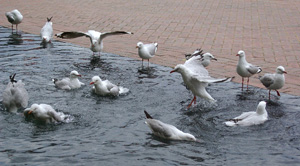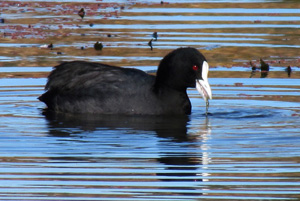Tom Parkinson's monthly column, introducing the diverse range of flora and fauna on show at Sanctuary Lakes.
 Silver Gulls enjoying a fresh water puddle after a downpour Bob Winters, in his excellent spotter's list of birds observed in Sanctuary Lakes, Skeleton Creek and Cheetham Wetlands, names over a hundred and twenty different birds residing in our area. To save us having to purchase expensive large binoculars and spend hours in hides balancing cameras with 300mm lenses, I thought this Rubik should look at probably the most common of the birds in our district - the "Silver Gull" and "Eurasian Coot". Each has an interesting back story, each is its own way very social, each can be aggressive to one another yet each is extremely successful at cohabitating with humans.
Silver Gulls enjoying a fresh water puddle after a downpour Bob Winters, in his excellent spotter's list of birds observed in Sanctuary Lakes, Skeleton Creek and Cheetham Wetlands, names over a hundred and twenty different birds residing in our area. To save us having to purchase expensive large binoculars and spend hours in hides balancing cameras with 300mm lenses, I thought this Rubik should look at probably the most common of the birds in our district - the "Silver Gull" and "Eurasian Coot". Each has an interesting back story, each is its own way very social, each can be aggressive to one another yet each is extremely successful at cohabitating with humans.
The Silver Gull (Chroicochepalus novaehollandiae) has a white head, body and tail with light grey and white mottled wings, and black tips on its tail and wings. Adults range from 40 cm to 45 cm in length. They have bright red beaks - the brighter the red, the older the bird. Silver Gulls are found along the entire Australian coast but seldom venture far out to sea. They are essentially a coastal bird rarely seen far from land that feeds mainly on plankton and other small marine animals, but more importantly, they also scavenge and have learnt to exploit human activities. They are familiar birds at rubbish dumps, sewerage outfalls, public parks, sea-fronts and lake-fronts. Because of this, their numbers have increased rapidly with the increase in the human population. In Sanctuary Lakes, they can be seen readily pestering humans for handouts of bread scraps and pilfering from unattended food containers.
Silver Gulls are gregarious but also very aggressive. When feeding, their social instincts are over-ridden by the competition for food and dominant birds establish a pecking order, driving off rivals that come too close.
But Silver Gulls also have a mystery. During the day you can see flocks around the lake and on the fringes of the golf course but it is very rare to see any in the evening or at night. Although pugnacious and daring when feeding, they are cautious and wary when roosting and will fly considerable distances to roost in areas that are surrounded by water so that they are safe from land predators. Silver Gulls are rarely seen around the district at sunrise. Most of the flocks fly to places like the Werribee Tip to scavenge for breakfast. Flocks will arrive at the Sanctuary Lakes area about two hours after sunrise. It is not known if these flocks are daily inhabitants or that their move here is related to where their morning scavenge has taken place. It is known that Silver Gulls will fly over 150 km to scavenge and roost and although the evidence is limited, they are probably not permanent residents at their day retreats.
Silver Gulls can breed at any time but usually between August and November. They nest in large colonies on offshore islands. Often two broods will be raised in a year and both adults share nest-building, incubation and feeding duties. Eggs are laid in very shallow nests, lined with vegetation.
The success of Silver Gulls adaptation to living and scavenging with human communities has created problems. With increased availability of food in the form of refuse, the population of Silver Gulls has exploded, and offshore islands which once supported small breeding colonies are now over-run. With so many gulls dominating these breeding islands, it is becoming increasingly difficult for terns and other seabirds to breed there. Do we let nature take its course or do we start to cull the Gulls?
 Eurasian Coot (Fulica atra) The Eurasian Coot (Fulica atra) is one of the persistently most common waterfowl in the Sanctuary Lakes area. Like the Gulls, Coots are often very aggressive towards each other but with the exception of their breeding season, they generally appear to ignore or get on with other species. Like the Gulls, they too have a night mystery.
Eurasian Coot (Fulica atra) The Eurasian Coot (Fulica atra) is one of the persistently most common waterfowl in the Sanctuary Lakes area. Like the Gulls, Coots are often very aggressive towards each other but with the exception of their breeding season, they generally appear to ignore or get on with other species. Like the Gulls, they too have a night mystery.
Although Eurasian Coots are established in many parts of the world, our Coots are distinctly an Australian variety - a plain dark grey bantam-sized bird with a black head, red eyes and a pure white beak and frontal shield. It is this white frontal shield that is responsible for the saying "as bald as a coot". Remember it is only in recent decades that bald has meant "hairless". Its original meaning was "white-headed".
The Australian Eurasian Coots feed almost entirely on vegetable matter, supplemented with only a few insects, worms and fish. Their main food of sea and water weed is mainly obtained from under water, starting with a very distinctive skyward jump, then a plunge to an underwater dive that can last up to 20 seconds and ranging down to 7 m in depth. Birds also graze for seeds on the land and on the surface of the water.
Eurasian Coots breed at any time that conditions are favourable and may produce successive broods. During the breeding season, pairs establish and maintain territories with vigour. Their aggression is also extended towards other species. Nests of ducks are often seized and used as roosting sites, the unfortunate owner's eggs being pushed off into the water. Young ducks and grebes are sometimes killed. The nest is often a floating raft of vegetation or is built on logs or tree stumps that are surrounded by water. Both sexes share incubation and care of the young. If food becomes scarce, the young birds may be killed by the parents.
Most of the ponds on the golf course have Coot's nests during the breeding season. On the second hole's pond is a reasonably large floating nest which is regularly used by Coots for nesting.
Coots prefer to paddle off when disturbed, but if suddenly surprised will skitter across the top of the water with their legs on or just above the surface, before folding their wings and gliding back into the water further away. When actually flying, which tends to happen at night, they hold their legs out behind them. Coots frequently travel en masse overnight, so can appear or disappear in places unnoticed by humans. Sometimes in order to escape their main predators - hawks, eagles and foxes - they will, after sunset, mass as a flock of up 200 birds into what looks like a small, swirling, black island barge of birds in the middle of the lake. The conditions, predator or weather that cause this strange manoeuvre remains a mystery.
Even though our Gulls and Coots are extremely populous, there is a lot we do not know about them. We don't even know if the birds we see daily are residents or nomadic. If they are nomadic, which a slight majority of experts believe, where do they come from and where do they go?